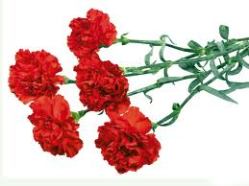What would funeral ceremonies be like without flowers? No flowers in a funeral service would mean an extremely lacklustre occasion. Although there are a variety of flowers, there are some kinds of flowers that are used in funerals. If you are experiencing any confusion in choosing funeral flowers, here are the different types of flowers that are suitable for this type of ceremony.
Lilies
Lilies are flowering plants that are native to the northern hemisphere. Lilies vary in height and can grow between 1 ft to 6ft. Lilies are large and emanate a beautiful fragrance. They come in colours such as yellow, white, orange, pink, red and purple. There are different types of lilies such as Tiger Lilies, Easter lilies, Calla lilies and Lily of the Valley. Lilies are commonly used at funeral ceremonies because of their symbolism of the restoration of the innocence of the deceased person. Calla lilies and Stargazer lilies are the two most popular flowers used. Calla lilies are widely considered as a symbol for reincarnation, while Stargazer lilies symbolize sympathy.
Roses
The rose is among the most popular of the species of flowers and belongs to the Rosacea family. There are over one hundred types of roses and they are available in a variety of colours such as red, pink, yellow and white. The best rose to use in a funeral ceremony is the dark crimson rose, which is a symbol of grief and sorrow. If you include a single rose in a bouquet, it is symbolic of your everlasting love for the deceased.
Chrysanthemums
Chrysanthemums can be traced as far back as the 15th century and were first planted in China. There are over 30 species of Chrysanthemums and they are available in colours such as yellow, purple, white and red. In countries such as Italy, France, Croatia, Spain and Hungary, the flower is symbolic of death, mourning and grief.
Carnations
These beautiful flowers emanate an intoxicating fragrance and are a popular choice for funerals. They were first used by the Greeks and Romans in garlands. The name carnation is derived from two Greek words “dios”, which means God and “anthos” which means flowers. As a result the flower is also known as the flowers of God. There are three types of carnations, large flowered carnations, which feature one large flower per stem, spray carnations which feature many smaller flowers and dwarf flowered carnations which feature many small flowers on one stem. Carnations are available in a wide variety of colours such as yellow, purple, green, white, pink, light red, dark red and striped. Pink carnations are symbolic of remembrance and are ideal for funeral ceremonies.
Gladiolas
The Gladiola is a beautiful, flamboyant flower and features over one hundred species. They have many different colours including red, white, pink, purple, yellow, orange, green and salmon. Gladiolas vary in height and can grow between 2 feet to 6 feet tall. The flower is used in funeral ceremonies in fan sprays and denotes moral integrity, honour, strength and remembrance.
Hyacinth
Hyacinths are quite stunning flowers and emanate a tantalizing fragrance when it blooms in the spring time. They vary in height and can grow between 8 inches and 12 inches. Purple hyacinths signify sorrow and are commonly used in funeral services.
Daffodils
There are over 15 species of Daffodils. They are very vibrant and beautiful flowers that are known to herald the beginning of spring. Daffodils vary in height and can grow between 2 inches and 20 inches. The colours of this flower vary and feature white yellow and deep orange varieties. Daffodils denote renewal and fresh starts and are ideal flowers to be given to the bereaved family.
Flowers play a very important role in funeral services. However, flowers for this occasion should be carefully selected due to the symbolism of many flowers. To ensure protocol, stick to the flowers listed above when selecting flower arrangements for this type of ceremony.







